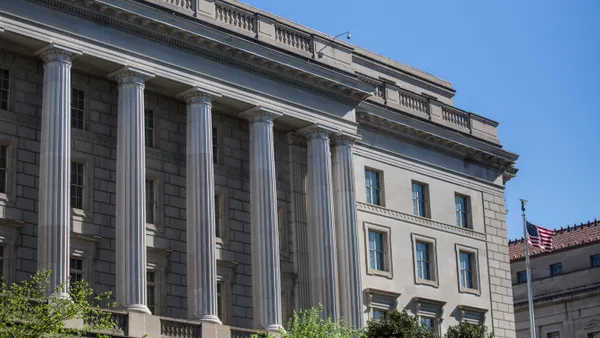Dive Brief:
- Financial institutions and other businesses this year have decisively turned away from the use of the London Interbank Offered Rate (LIBOR), the Federal Reserve said, citing progress in business loans, securitizations, floating-rate note markets and interest-rate swaps trading.
- “There has been a clear shift away from the use of U.S. dollar (USD) LIBOR as a reference rate in financial contracts since the start of the year,” the central bank said in its bi-annual Financial Stability Report. “This shift is consistent with supervisory guidance.”
- Syndicated loans, although “slower to move away from LIBOR, shifted almost entirely to SOFR-referenced products in early 2022,” the Fed said, referring to the Secured Overnight Financing Rate. Regarding non-syndicated loans, “supervisory assessments indicate that most banks have reduced LIBOR lending sharply since the start of the year, with most loans now referencing SOFR,” which is the reference rate preferred by regulators.
Dive Insight:
Financial institutions and companies seeking loans are sunsetting LIBOR after years of pressure from the Fed and other regulators worldwide.
The subject of a manipulation scandal in 2012, LIBOR is the reference rate for trillions of dollars in mortgages, derivatives, business loans and other financial contracts. It is derived from London banks' estimates of what they would be charged when borrowing from other banks. SOFR is based on overnight repurchase agreements secured by U.S. Treasurys.
The final fixings for most LIBOR rates — including one-week and two-month U.S. dollar LIBOR — were made on Dec. 31, but other U.S. dollar tenors may continue until June 30, 2023.
As of March 2021, $223 trillion in contracts referenced LIBOR, with $74 trillion maturing after June 2023, according to the Alternative Reference Rates Committee, a panel of financial institutions convened by the New York Fed.
Regulators are “reaching the endgame” to the phaseout of LIBOR, Rostin Behnam, chairman of the Commodity Futures Trading Commission, said Thursday.
“New alternative rates with liquid markets for swaps and futures are building around them and are gaining momentum,” Behnam said in a speech, affirming the commission’s endorsement of SOFR. Cooperating with other regulators to wind down LIBOR “has been one of the most rewarding exercises.”
Yet LIBOR use persists in some financial contracts, especially in options and exchange-traded futures, “where supervised entities play a less significant role,” the Fed said.
Although SOFR futures have gained ground, “LIBOR has still accounted for a substantial proportion of interest rate futures trading,” the central bank said. “Because futures markets play an important role in helping end users hedge their risks, which are now associated with SOFR, it will be important to see continued progress away from LIBOR over this year.”















